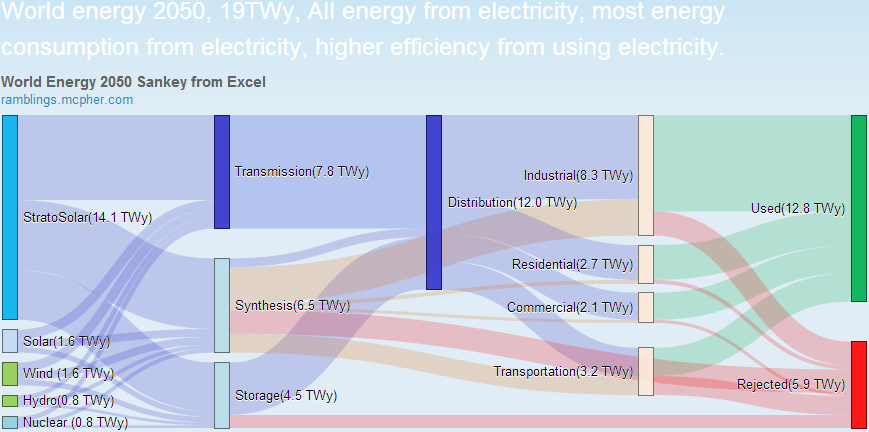|
All approaches to eliminating CO2 emissions rely on a transition to a predominately electricity based energy system. We have EIA projections for energy demand in 2050, so it is possible to model different fossil fuel free energy systems that meet this energy demand. This is not an attempt to predict how the future will unfold, but by showing all the pieces and their relationships it helps in understanding the impact of various technologies on the overall system.
Today there is no significant electricity storage, and fuel synthesis from electricity is equally insignificant. The need to handle intermittent energy sources, and the need to provide liquid fuel for transportation mean that both technologies are necessary at significant scale by 2050 if fossil fuels are to be replaced. The relative cost of energy from each and the sector energy efficiency and demand for either fuel or electricity will determine the relative size of storage and synthesis. The range of possible outcomes is large and dependent on too many variables to predict. We only show centralized large scale storage but distributed storage at the destination, like batteries in transportation, residential or commercial sectors will also affect the balance of demand between fuel and electricity. Fuel synthesis and electricity storage only exist today as small research prototype systems. Alternative energy is too expensive, and synthesis and storage add considerable expense on top of the cost of energy they take in, so there is no economic incentive to invest in either. The fundamental enabler for storage and synthesis is cheap electricity. Today we make electricity from fossil fuel. An electricity economy inverts this and makes synthetic fuel from electricity. If the synthetic fuel has to compete with fossil fuel, it needs to be cheaper. This means electricity has to be very cheap. Today's $4.00/gal gasoline is $0.10/kWh. The cost of electricity plus the cost of paying for the synthesis plant have to at least match this. If StratoSolar electricity costs $0.06/kWh initially, that leaves $0.04/kWh to pay for synthesis and conversion energy losses. That's about $0.80/Wp capital cost. That capital cost is a stretch for mature fuel synthesis but is not possible with today's technology. Investing in these technologies at the scale necessary for the decade or so needed will only happen when it is clear that electricity is cheap and will get cheaper. So the clean energy cost target is not competing with today's electricity, but being considerably cheaper. Wind and solar are about a factor of two too expensive to compete with electricity in favorable markets today. That makes them four to six times too expensive to compete with fossil fuels using synthetic fuels. Sankey diagrams are very useful for visualizing energy systems. They simultaneously show the elements of a system and their interconnectedness, along with a quantative representation of the magnitudes of the elements and the energy flows between them. Here are sankey diagrams for two possible StratoSolar driven energy scenarios that satisfy the projected energy demand in 2050. The first scenario assumes that the sectors consume fuel and energy like they do today. The second scenario assumes that sectors adjust to consume more of the considerably cheaper electricity, and their efficiency improve because of this. By Edmund Kelly
Comments
|
Archives
December 2023
Categories
All
|
|
© 2024 StratoSolar Inc. All rights reserved.
|
Contact Us
|



 RSS Feed
RSS Feed